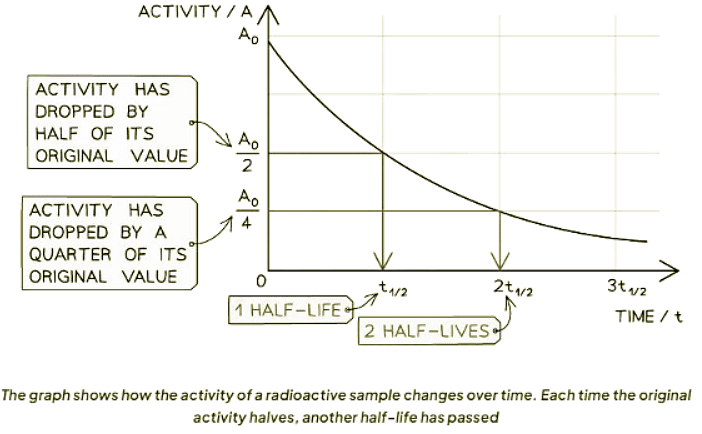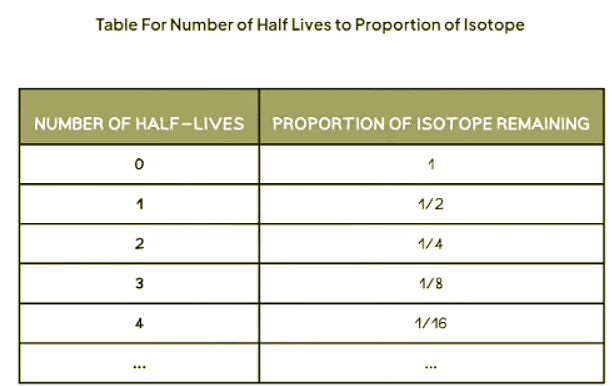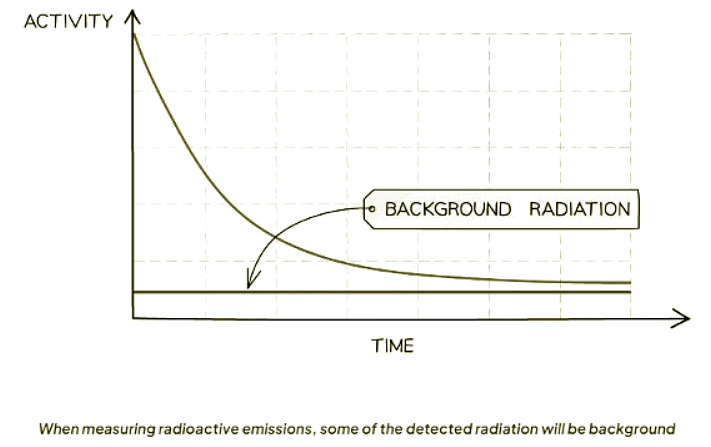Year 11 Exam > Year 11 Notes > Physics for GCSE/IGCSE > Half-Life
Half-Life | Physics for GCSE/IGCSE - Year 11 PDF Download
Half-Life Basics
- Predicting the exact moment when a specific unstable nucleus will decay is impossible.
- However, it's feasible to determine the rate at which the activity of a sample decreases.
- This rate is quantified as the half-life.
- Half-life is defined as the duration required for half of the nuclei of a particular isotope in any sample to decay.
- In simpler terms, it's the time for the activity of a sample to reduce to half of its initial level.
- Various isotopes exhibit different half-lives, ranging from fractions of a second to billions of years.
- Half-life can be deduced from an activity–time graph.

- The half-life is the duration needed for the activity of a sample to decline from 100% to 50%.
- This period is equivalent to the time required for the activity to drop from 50% to 25%.
- The half-life remains consistent for a specific isotope.
- Half-life data can also be illustrated in tabular format.
- With each successive half-life, the proportion of remaining isotopes halves.

Half-Life Graphs
- Begin by identifying the initial activity of the sample, noted where the line intersects the y-axis, labeled as A0.
- Halve this value and locate where this halved activity occurs on the graph.
- Trace horizontally from this halved value on the y-axis to the nearest point on the curve.
- Then, draw a vertical line downwards from that point until it intersects the x-axis.
- The intersection point on the x-axis denotes the half-life.
- In essence, the half-life represents the time taken for the activity to diminish to half of its original value.
Question for Half-LifeTry yourself: What is the definition of half-life?View Solution
Background Radiation
- Background radiation constitutes the constant radiation inherent in the surrounding environment.
- Consequently, during any radiation-related experiment, a portion of the detected radiation will be attributed to background radiation.
- In experiments aimed at measuring half-life, it's imperative to consider the existence of background radiation.

- To do this you must:
- Begin by assessing background radiation levels (without any additional sources) – referred to as the background count.
- Proceed with the experiment as planned.
- Adjust each reading by subtracting the background count, yielding a corrected count.
- The corrected count serves as the most accurate estimation of radiation emitted by the source, essential for half-life measurement.
The document Half-Life | Physics for GCSE/IGCSE - Year 11 is a part of the Year 11 Course Physics for GCSE/IGCSE.
All you need of Year 11 at this link: Year 11
|
127 videos|148 docs|35 tests
|
FAQs on Half-Life - Physics for GCSE/IGCSE - Year 11
| 1. What is the concept of half-life in relation to radioactive decay? |  |
Ans. Half-life is the time taken for half of the radioactive nuclei in a sample to decay. It is a characteristic property of each radioactive isotope.
| 2. How is half-life represented on a graph of radioactive decay? |  |
Ans. On a graph of radioactive decay, half-life is represented by the time it takes for the activity of a radioactive sample to decrease to half of its original value.
| 3. How can half-life be used to determine the age of a radioactive sample? |  |
Ans. By measuring the remaining amount of a radioactive isotope in a sample and knowing its half-life, scientists can calculate how long ago the sample was formed.
| 4. Why is understanding half-life important in fields such as medicine and environmental science? |  |
Ans. Understanding half-life is important in medicine for determining the decay rates of radioactive isotopes used in medical imaging and treatments. In environmental science, it helps in assessing the impact of radioactive contaminants on ecosystems.
| 5. How can scientists calculate the half-life of a radioactive isotope in a laboratory setting? |  |
Ans. Scientists can calculate the half-life of a radioactive isotope by measuring the decay rate of a sample over a period of time and using the formula for half-life calculations.
Related Searches





















